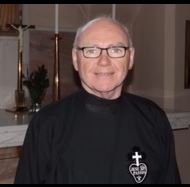When the weather took a turn for the better during last week Brother Antony decided to cycle into the Church, taking the Kirkintilloch/Springburn Road on the way in, and coming back via the Forth and Clyde Canal. He did invite me to join him but I declined as cycling has never been something I enjoyed. In fact, when I first joined the Passionists in 1975, at the age of 24, I am embarrassed to say that I couldn’t even ride a bike. The only bike I had ever
ridden prior to that was a three-wheeler at a very young and tender age.
My first year as a Passionist, the Postulancy year, was spent at the Graan in Enniskillen, and I was informed that, when I would go to Mount Argus in Dublin for studies the following year, I would need to be able to ride a bike, as that was the only means of transport that was
available to the students, apart from Shanks’s Pony, and it would be far too far to walk the road to the college on a regular basis. And so, I was given a big black bike with no gears and began, in the little free time that was available to us, to practice cycling around the country roads of County Fermanagh. After a very shaky start I eventually managed to get proficient enough so as not to dread too much what lay in store in Dublin. It was only as the Postulancy year drew to a close that the rector of the Graan told me how much I had been entertaining the local farmers and their families in my early attempts, when it seemed that the only way I knew how to stop the bike was by crashing into the nearest dry-stone wall, a few of which I then toppled over, head first.
Of course, cycling around the country roads of County Fermanagh was a very different
prospect from cycling along the manic roads of Dublin. When I arrived at Mount Argus there were twenty-one of us on the student corridor. Many possessed their own bikes, with multiple gears, but I was given one of the bikes I mentioned a few weeks ago that came out of the lost or stolen property store of the Irish Police. It resembled a great deal the one I had in
Enniskillen. Around that time there had been a popular science-fiction film out called
Rollerball, starring James Caan. Rollerball was a violent sport in which two teams clad in body armour roller skated around a banked, circular track, a bit like a velodrome. The object of the game was to score points by throwing a steel ball into a goal. The skaters however had unbridled leeway to attack and barge the opposing players so as to take possession of the ball, and the Passionist students at Mount Argus, inspired by this, had adopted this method on the daily cycle to college. This generally meant that whenever we were stopped at traffic lights, and the twenty-one bikes were lined up like Formula One racing drivers, ready to launch off when the lights changed to green, they would begin to barge one another and try to knock each other off their bikes so as to get ahead of the pack. I know, as I write this, that Brother
Antony would have loved it as there is nothing he likes better than a bit of danger. After my first few experiences of this, and still not being a confident cyclist, I adopted the method of hanging back and accepting the ignominy of being the last in college every day.
Once my student days were over I didn’t cycle very much, although, during my studies in
Italy, I was taken by a cycling mad Passionist to a place about 40 miles north of Milan, on top of a steep hill that climbs up from the shores of Lake Como, to the Church of Madonna del Ghisallo. Over many years this church had become an established stopping point for cycling
enthusiasts and, in 1949, Pope Pius XII recognised the cycling community's adoption of this little church and gave Madonna del Ghisallo the title of Patron Saint of Cycling. The Church is now a bike lover's paradise, its walls absolutely covered with cycling paraphernalia, much of it donated by professional cyclists who made a pilgrimage to worship at the Shrine after
winning a race, or to pray for some special intention. There is also a museum close by that
collects and displays artefacts from cycling history. The cycle up to that church nearly killed me and I pray to Madonna del Ghisallo regularly that I will never, ever, get on a bike again.

 RSS Feed
RSS Feed
